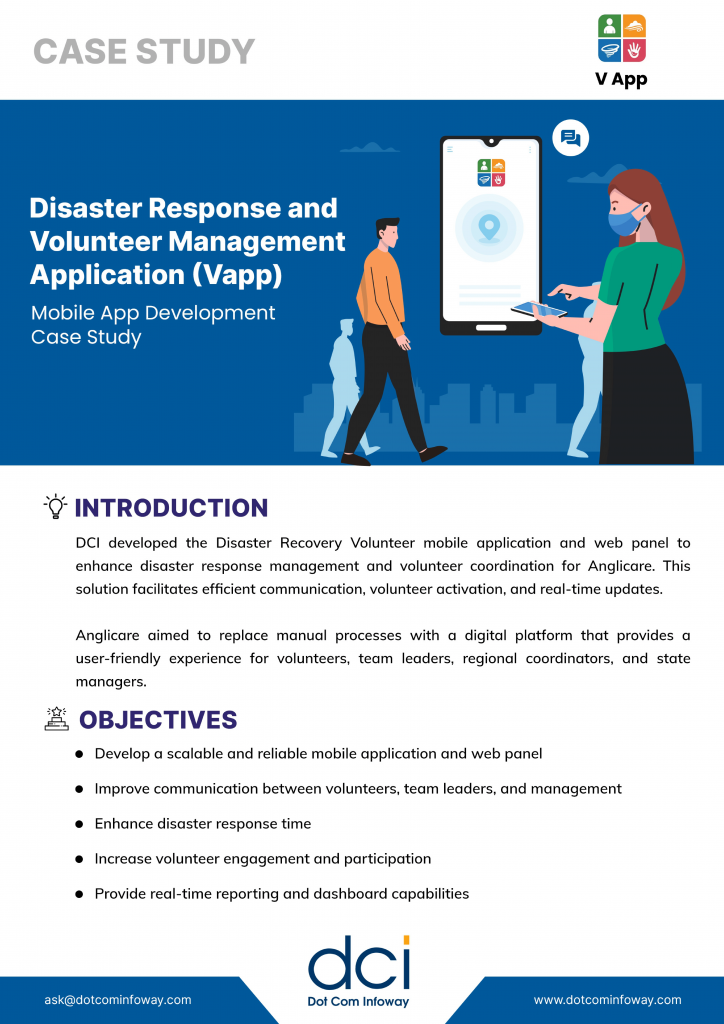Disaster Response and Volunteer Management Application (Vapp) – Mobile Application Development Case Study
Introduction
DCI developed the Disaster Recovery Volunteer mobile application and web panel to enhance disaster response management and volunteer coordination for Anglicare. This solution facilitates efficient communication, volunteer activation, and real-time updates.
Anglicare aimed to replace manual processes with a digital platform that provides a user-friendly experience for volunteers, team leaders, regional coordinators, and state managers.
Objectives:
- Develop a scalable and reliable mobile application and web panel
- Improve communication between volunteers, team leaders, and management
- Enhance disaster response time
- Increase volunteer engagement and participation
- Provide real-time reporting and dashboard capabilities
Challenges:
The development of the volunteer broadcast and activation tool posed several challenges:
Technical Challenges:
- Ensuring seamless communication between volunteers, team leaders, regional managers, and state managers.
- Implementing real-time notifications and updates.
- Developing a scalable and reliable platform.
- Integrating robust reporting and dashboard capabilities.
- Ensuring data security and privacy.
Functional Challenges:
- Managing volunteer availability and activation.
- Tracking volunteer check-in/check-out and event participation.
- Implementing badge systems for volunteer recognition.
- Providing hierarchical access to volunteer information.
Project Management Challenges:
- Coordinating with multiple stakeholders (state managers, regional managers, team leaders, volunteers).
- Managing competing priorities and timelines.
- Ensuring seamless integration with existing systems.
Scalability Challenges:
- Handling large volumes of users and events.
- Ensuring platform stability during peak usage.
- Scaling reporting and dashboard capabilities.
Security Challenges:
- Protecting sensitive volunteer and event information.
- Preventing unauthorized access.
- Ensuring data integrity.
By addressing these challenges, the development team successfully created a robust and effective volunteer broadcast and activation tool.
Proposed Solution:
Overview:
The Disaster Recovery Volunteer mobile application (available on the App Store for iOS and Android) is designed to streamline volunteer management during disaster response efforts. The application facilitates efficient communication, volunteer activation, and real-time updates.
Key Components
1. Broadcast Module
– State Managers/Regional Coordinators create events (disasters)
– Volunteers receive broadcasts via push notifications
– Volunteers acknowledge receipt and inform availability
2. Volunteer Management Module
-Volunteer profiles with availability status
-Volunteer activation/deactivation
-Check-in/check-out and event participation tracking
3. Badge System
– Volunteers earn badges for participating in events
– Badges visible to volunteers and hierarchical leaders
4. Dashboard and Reporting
– Real-time updates for State Managers, Regional Managers, and Team Leaders
– Customizable dashboards for event and volunteer management
– Automated reporting for improved decision-making
5. Notification System
– Push notifications for events, updates, and reminders
– In-app messaging for seamless communication
Technical Specifications
- Front-end: Native Android and iOS development using Java and Swift
- Back-end: RESTful API using Node.js and Express.js
- Database: MySQL for data storage and scalability
- Cloud Infrastructure: AWS for reliability and scalability
- Security: End-to-end encryption, secure authentication, and authorization
Implementation Roadmap
- Requirements gathering and scope definition (2 weeks)
- UI/UX design and prototyping (4 weeks)
- Mobile application development (16 weeks)
- Testing and quality assurance (8 weeks)
- Deployment and training (4 weeks)
Benefits
- Enhanced communication and collaboration
- Improved volunteer engagement and participation
- Streamlined event management
- Real-time reporting and dashboard capabilities
- Scalable and reliable platform
Phases:
The project was divided into two phases to ensure a structured approach:
Phase 1: Foundation and Core Features (12 weeks)
Objectives:
- Develop core application features
- Establish scalable architecture
- Implement essential functionality
Deliverables:
- Requirements gathering and scope definition
- UI/UX design and prototyping
- Mobile application development (Android and iOS)
- Backend API development (Node.js and Express.js)
- Database design and implementation (MySQL)
- Basic reporting and dashboard capabilities
- Volunteer broadcast and activation tool
- Volunteer profile management
- Event management (creation, update, deletion)
- Push notification integration
Key Features:
- Volunteer registration and login
- Event creation and broadcast
- Volunteer availability and activation
- Event check-in/check-out tracking
- Basic reporting (event participation, volunteer engagement)
Phase 2: Foundation and Core Features (12 weeks)
Objectives:
- Enhance application functionality
- Implement advanced reporting and dashboard capabilities
- Integrate badge system and hierarchical leadership features
Deliverables:
- Advanced reporting and dashboard capabilities
- Badge system implementation
- Hierarchical leadership features (access control, volunteer management)
- Integration with existing systems (if applicable)
- Security enhancements (end-to-end encryption, secure authentication)
- Performance optimization and testing
- Training and documentation
Key Features:
- Customizable dashboards for event and volunteer management
- Automated reporting for improved decision-making
- Volunteer badge system with hierarchical leadership visibility
- Enhanced event management (volunteer assignment, task management)
- Integration with social media platforms (optional)
Results Achieved:
We successfully launched the Disaster Recovery Volunteer app on the Play Store and App Store, receiving exceptional ratings. This innovative platform:
– Simplified volunteer management
– Enabled efficient communication
– Amplified disaster response efforts
Our client is thrilled, and we’re grateful for the collaboration.







